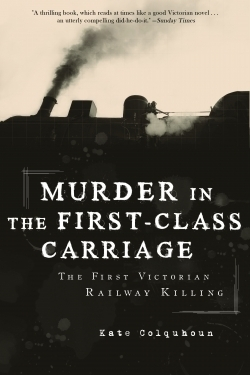Murder in the First-Class Carriage
The First Victorian Railway Killing
Before forensic science was widely accepted, police relied on experience, intuition, tips, concrete clues, and patient footwork rather than on microscopic samples. This distinguished account of the 1864 crime that shook Victorian England begins with scant objects—a forgotten hat and stolen watch—as well as circumstantial evidence that quickly traced a path toward the suspect, a German tailor whose cross-Atlantic escape was stopped by the legendary Scotland Yard.
London-based author Colquhoun (author of The Busiest Man in England: A Life of Joseph Paxton, Gardener, Architect & Victorian Visionary) contextualizes the murder of Thomas Briggs in an era that proliferated with “sensation” novels (which often depicted unsavory events in commonplace settings) and the fear of change wrought by industrialization. At that time, compartments on British trains were isolated and passengers had no means of communicating with the conductor. That a respectable banker could be attacked while traveling, and that it might have been prevented, especially struck the public, as criticism had already surfaced regarding railway safety, and news reports further heightened concern.
Colquhuon masterfully chronicles the chase, extradition, and trial. She reveals a man who repeatedly proclaimed his innocence until the last moment, a system determined to convict him despite the absence of a clear motive and weapon (among other telling details), and a public divided between grim spectators and supporters who doubted that enough proof existed. The result is uncannily prescient in its portrayal of the media. Much like the notorious crimes of today, the Briggs murder made headlines even on distant shores. It also became a source for commercial exploitation, from inclusion of the suspect in Madame Tussaud’s House of Horrors to unauthorized reproductions of his photo.
More than a well-spun tale of searching for justice amid hype, Murder in the First-Class Carriage reveals the underside of Victorian life, where interest in the macabre flourished alongside the propriety modern readers may expect. Fans of true crime and the general reader alike will appreciate Colquhuon’s talent for enlivening facts with everyday moments. The story is especially noteworthy for its balance between highlighting the case itself and the atmospheric, gas-lit city in which it occurred.
Reviewed by
Karen Rigby
Disclosure: This article is not an endorsement, but a review. The publisher of this book provided free copies of the book to have their book reviewed by a professional reviewer. No fee was paid by the publisher for this review. Foreword Reviews only recommends books that we love. Foreword Magazine, Inc. is disclosing this in accordance with the Federal Trade Commission’s 16 CFR, Part 255.

